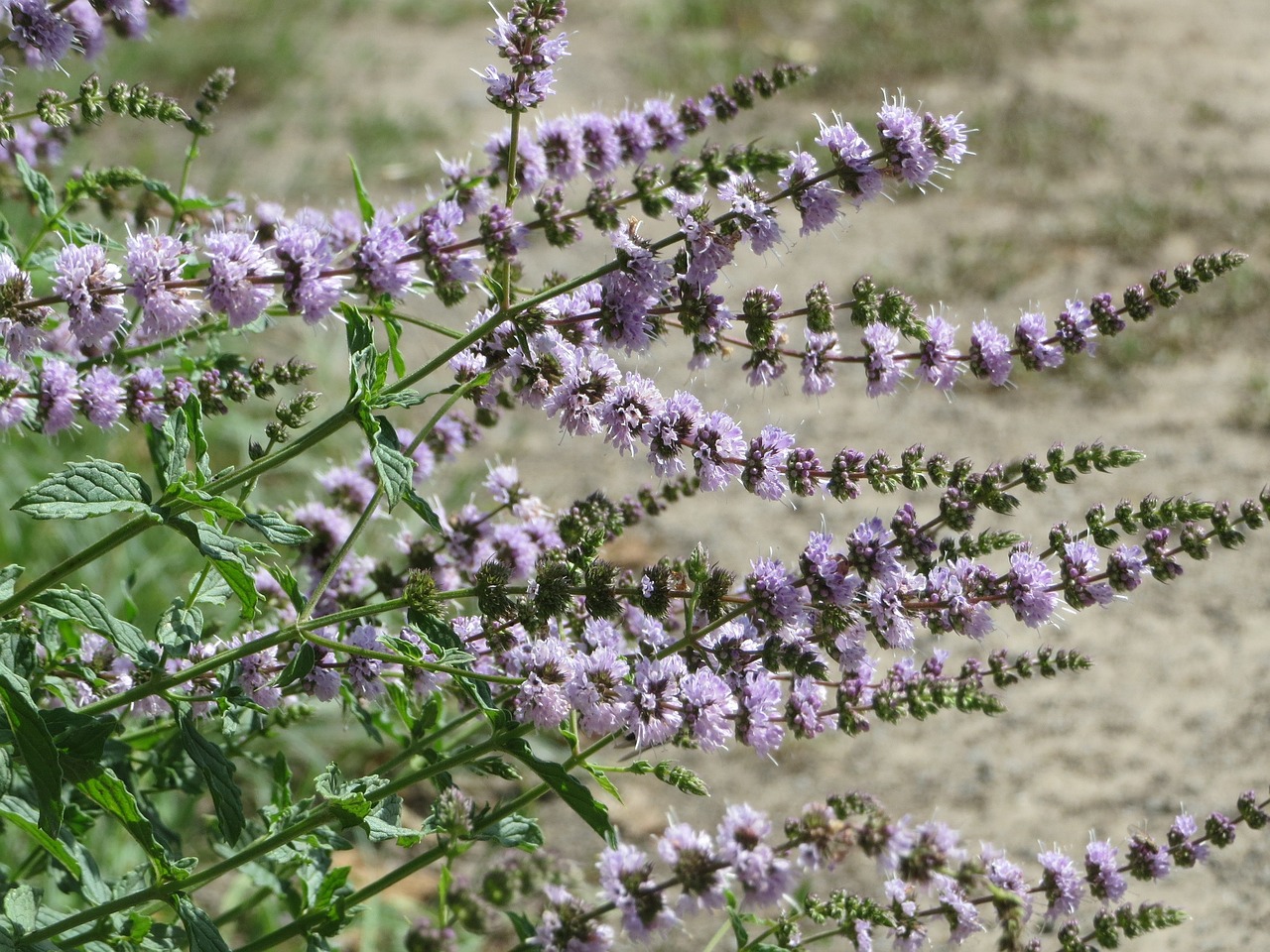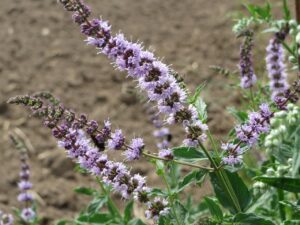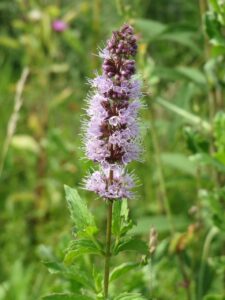Spearmint
Nicolas Duval
·
·
Overview
Spearmint, or Mentha spicata, is a perennial herb with a refreshing aroma, stemming from the Lamiaceae family. It is prized for its minty, slightly sweet flavor and is commonly used in cooking, cosmetics, and traditional medicine due to its therapeutic properties, such as anti-inflammatory and antioxidant effects. While not recommended for smoking, it is enjoyed in teas and various culinary dishes.
Common name(s): Garden mint, common mint, lamb mint, mackerel mint.
Scientific name: Mentha spicata L.

Characteristics
Known for its refreshing fragrance, square-shaped stems, oval-shaped leaves with toothed edges, and small variably colored flowers.
Region
Spearmint is native to Europe and southern temperate Asia but is now cultivated globally.
Natural Habitat
Spearmint is typically found in wet environments such as stream banks, meadows, and field edges.
Cultivation
Prefers full sun to partial shade, regular watering without waterlogging, and well-drained, fertile soil with a pH of 6.0 to 7.0.
Traditional Usage
Traditional use of spearmint has revealed its versatile role in natural remedies. Here are some of the ways this aromatic herb has been employed over time:
- Alleviating symptoms of colds and coughs
- Reducing asthma-related discomfort
- Combatting fever
- Aiding in the management of obesity
- Addressing jaundice
- Easing digestive issues
Its therapeutic properties are why spearmint has long been a staple in home apothecaries. Whether through teas or topical applications, spearmint has stood the test of time as a beneficial herbal ally.
Historical Usage
Used for colds, coughs, asthma, fevers, obesity, jaundice, and digestive issues in traditional medicine.
Common Usage
Currently used for culinary flavoring, in beverages, as a digestive aid, and in oral care products.
Effects
Spearmint is cherished for its distinctive minty scent and flavor. This herb benefits the body in several ways, with particular emphasis on digestive and respiratory health. Its calming properties make it a go-to natural remedy for aiding in relaxation and comfort for various ailments. Here’s a look at the general effects of spearmint on the body:
- Calming Digestive System: Spearmint is well-known for easing digestive discomfort and promoting healthy digestion.
- Soothing Respiratory Ailments: It can also help alleviate respiratory concerns due to its soothing properties.
- Anti-inflammatory Effects: Spearmint has potential anti-inflammatory benefits that contribute to its therapeutic uses.
- Antioxidant Benefits: The presence of antioxidants in spearmint supports the body’s ability to fend off oxidative stress.
- Antimicrobial Properties: With antimicrobial elements, spearmint can assist in defending against certain pathogens.
- Menthol Sensation: A cooling effect is experienced, mostly attributed to the menthol content, providing a refreshing sensation.
These benefits underscore the reasons spearmint has been traditionally valued and why it continues to be used to promote well-being in various ways1. Whether enjoyed as a tea, used in culinary creations, or for its aromatic qualities, spearmint’s gentle, beneficial properties can be a pleasant addition to your holistic health routine.

Spearmint is valued for its ability to ease digestive troubles, alleviate respiratory conditions, and impart a refreshing cooling effect.
Effects when smoking
When considering the effects of smoking spearmint, it’s important to proceed with caution. Spearmint has a reputation for its soothing effects on the digestive system and its ability to alleviate respiratory conditions. However, these benefits are most commonly experienced through ingestion, as in teas or culinary uses, rather than smoking.
Smoking spearmint—or any herb—can result in the inhalation of potentially harmful byproducts. The act of smoking itself may introduce toxins into the lungs, which is generally unfavorable for respiratory health. Given these concerns, smoking spearmint is not traditionally recommended.
For those looking to enjoy the fresh, minty flavor of spearmint, the recommended alternative is to brew teas or to incorporate the herb into food. This approach allows you to experience the cooling sensation of menthol and the possible therapeutic effects, while avoiding the risks associated with smoking.
In summary, while spearmint has various uses and potential health benefits, smoking is not an advised method of consumption. Enjoying spearmint in tea or as a culinary herb remains the safer and more conventional option.
Flavor Profile
Fresh, minty, and slightly sweet flavor profile.
Edible Parts
Leaves
Effects when Smoked
Effects of smoking spearmint are not well-documented, and it may introduce harmful byproducts to the lungs; hence smoking is not recommended.
User Experiences
Users typically report a refreshing and cooling sensation with a pleasant taste and potential digestive benefits when using spearmint.
Medicinal Benefits
Spearmint is praised not only for its aromatic and culinary flair but also for its suite of potential health benefits. These medicinal qualities span a variety of uses and leverage the active compounds within the plant. Here’s a glance at some of the potential medicinal benefits associated with spearmint:
- Anti-inflammatory effects: May help to alleviate inflammation and associated conditions.
- Antioxidant properties: Spearmint contains compounds that can combat oxidative stress, contributing to overall health.
- Antimicrobial action: It may help in fighting off certain pathogens due to its antimicrobial properties.
- Gastrointestinal support: Spearmint has been traditionally used to ease digestive issues and soothe the stomach.
- Respiratory relief: The herb may aid in relieving symptoms associated with respiratory ailments.
While spearmint is generally considered safe, moderation is key, as excessive use can lead to adverse effects1. It’s advisable to consult with a healthcare provider for therapeutic use, ensuring personal health and well-being.
History and Folklore
- Spearmint, with origins in Europe and southern temperate Asia, has maintained its prominence for centuries.5
- The herb’s refreshing quality led to its incorporation in traditional medicine, treating a range of ailments from colds to digestive issues.1
- As a flavoring agent, its cultivation and usage eventually gained global momentum, solidifying spearmint’s status in culinary traditions worldwide.5

A long-standing herbal tradition from Europe to Asia, spearmint offers refreshing qualities that translate into medicinal uses and a favored culinary flavor, cherished for centuries.
Side Effects and Contraindications
- Excessive intake of spearmint may lead to heartburn or allergic reactions. It’s important to consume it in moderation.
- While generally safe, spearmint can have contraindications for some individuals. For example, spearmint may affect hormone-sensitive conditions; thus, it should be used with caution in such cases.
- It’s recommended to consult a healthcare provider before using spearmint for therapeutic purposes to avoid potential adverse effects.
Legal Status
Spearmint is legal and can be readily obtained with no restrictions on its use or cultivation. It is often grown in home gardens and used in a variety of applications, from culinary to medicinal without any legal concerns. This accessibility reflects spearmint’s status as a non-controlled, widely accepted herb, ensuring that you can incorporate it into your home practices with peace of mind.
References
1. “The traditional uses, phytochemistry and pharmacology of spearmint …” ScienceDirect, https://www.sciencedirect.com/science/article/pii/S0378874121004931
2. “USDA Plants Database,” USDA, https://plants.usda.gov/home/plantProfile?symbol=Mesp3
3. “Spearmint – Mentha spicata | Plants | Kew,” Kew, https://www.kew.org/plants/spearmint
4. “Spearmint: Plant Care & Growing Guide – The Spruce,” The Spruce, https://www.thespruce.com/how-to-grow-spearmint-5086858
5. “Spearmint – Wikipedia,” Wikipedia, https://en.wikipedia.org/wiki/Spearmint
Image Credit: WikimediaImages
Image Credit: WikimediaImages
Image Credit: WikimediaImages
Nicolas Duval
Nicolas is a passionate advocate for nature and the art of wildcrafting. His dedication shines through in Wildcraftia, a website he meticulously crafted to serve as a haven for nature enthusiasts worldwide. Driven by a deep appreciation for nature’s connection to humanity, Nicolas embarked on his journey in 2011 with SmokableHerbs, a platform showcasing his love for nature’s bounty. Building upon this foundation, he established Smokably, a thriving online store offering premium herbs and blends to a global audience.
